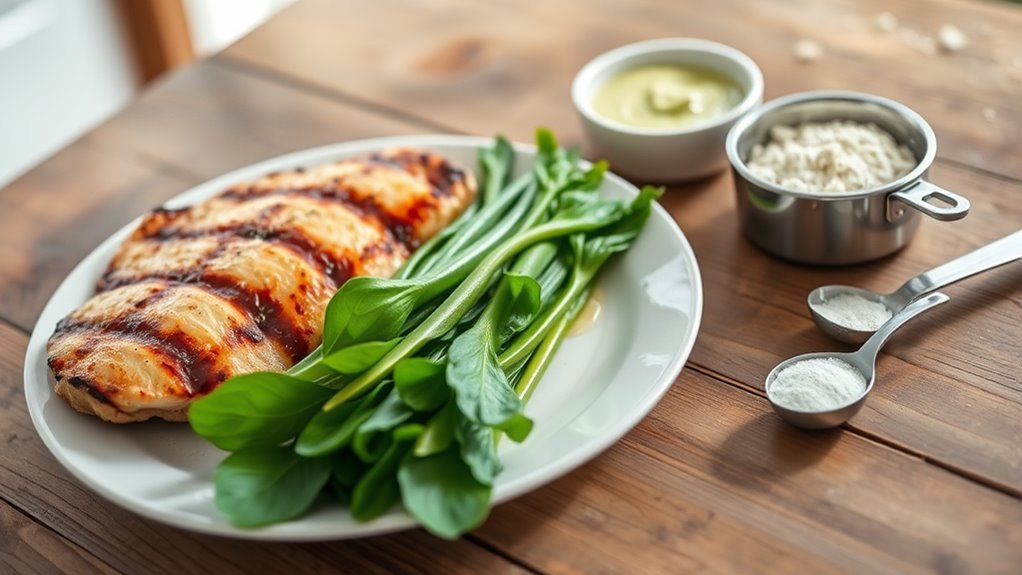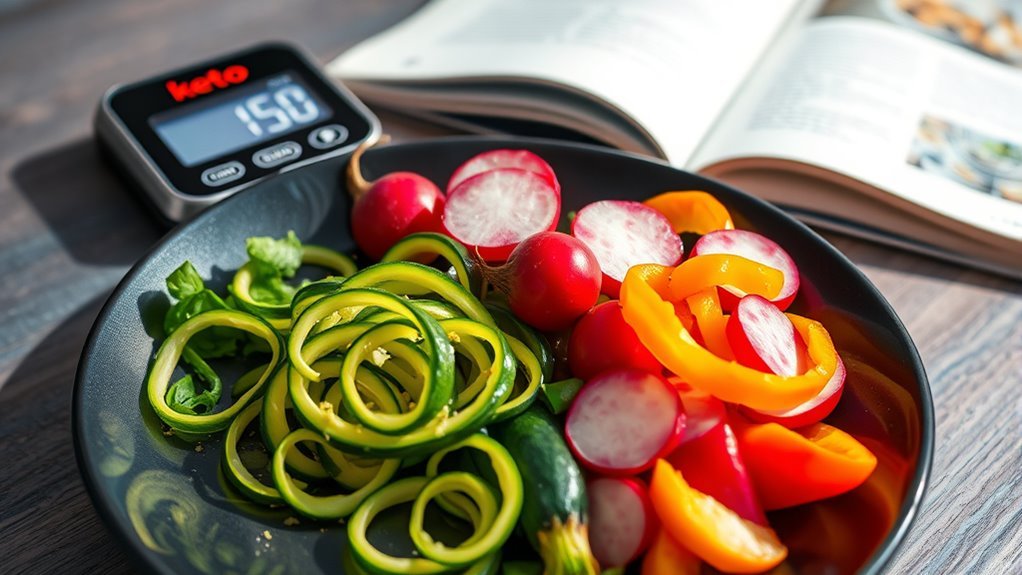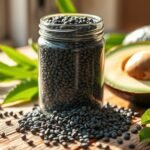On a ketogenic diet, you should aim to consume between 20 to 50 grams of carbohydrates daily to stay in ketosis and promote fat burning. This limit can vary based on your individual factors, such as metabolism and activity level. To maximize your results, focus on low-carb foods like leafy greens, avocados, and healthy fats. If you want to discover more about carb limits and meal ideas, there’s plenty more to explore on this journey.
Understanding Ketosis and Carbohydrate Limits

When you’re looking to enter ketosis, understanding your carbohydrate limits is essential. The process of ketosis allows your body to burn fat for fuel, which can lead to numerous ketosis benefits, including weight loss and improved mental clarity. To achieve this metabolic state, you’ll typically need to limit your daily carb intake to around 20-50 grams. This means being mindful of your carbohydrate sources—opt for non-starchy vegetables, nuts, and seeds while avoiding sugars and grains. By knowing your limits and choosing low-carb options, you can enjoy the freedom that comes with a ketogenic lifestyle. This understanding not only helps you reach your goals but also supports long-term health as you navigate your dietary choices with confidence.
General Carb Guidelines for the Ketogenic Diet

When starting a ketogenic diet, it’s essential to understand your daily carb limit, which typically ranges from 20 to 50 grams for most people. You’ll also want to differentiate between net carbs and total carbs, as this can greatly impact your ability to maintain ketosis. By following these guidelines, you can better tailor your diet to achieve ideal results.
Daily Carb Limit
The daily carb limit on a ketogenic diet typically ranges from 20 to 50 grams, depending on individual factors like activity level and metabolic health. It’s essential to find your personal tolerance, as some may thrive on the lower end while others can handle more. Carb cycling is another strategy you might consider, allowing you to increase carbs on certain days to support workouts or recovery. This flexibility can help maintain a healthy relationship with food while still pursuing your keto goals. Remember, it’s not just about cutting carbs; it’s about finding what works best for you. Listen to your body, track your progress, and adjust as needed to create a sustainable and enjoyable ketogenic lifestyle.
Net vs. Total Carbs
Understanding the difference between net and total carbs is essential for anyone following a ketogenic diet. To maintain ketosis, you need to focus on the right carb count. Total carbs include all carbohydrates, while net carbs subtract fiber and certain sugar alcohols, as they don’t impact blood sugar levels greatly. Here’s a quick breakdown:
| Carbohydrate Type | Definition | Importance |
|---|---|---|
| Total Carbs | All carbs in a food item | Helps calculate overall intake |
| Fiber | Indigestible carbs | Lowers net carb calculation |
| Net Carbs | Total carbs minus fiber | Critical for maintaining ketosis |
Understanding net carb calculation can empower you to enjoy more freedom in your food choices while respecting total carb importance on your keto journey.
Individual Factors Affecting Carbohydrate Intake

While many people turn to the ketogenic diet for its potential benefits, individual factors play a crucial role in determining how many carbs you should consume. Your individual metabolism is key; some people can handle more carbs without affecting ketosis. Activity level also matters—if you’re highly active, you might need a few more carbs for energy. Age factors can influence metabolic rates as well, meaning older adults may require fewer carbs. Additionally, existing health conditions and weight goals will shape your carb intake. Finally, your insulin sensitivity is essential; those with higher sensitivity may tolerate carbs better than others. By considering these factors, you can tailor your carb consumption to fit your unique needs and lifestyle.
Tracking Your Carb Consumption Effectively
To successfully maintain a ketogenic diet, tracking your carb consumption is essential, as it helps guarantee you stay within your target range for ketosis. Start by using a carb tracking app or a simple notebook to keep daily consumption logs. Record every meal and snack, noting not just total carbs but also net carbs, which account for fiber and sugar alcohols. This practice not only increases awareness of what you’re eating but also makes it easier to identify potential carb-heavy foods that could disrupt your progress. Consistency is key; review your logs regularly to spot patterns and adjust your intake as needed. With effective tracking, you’ll enjoy the freedom to make informed choices while staying on track with your keto goals.
Foods to Include and Avoid on a Keto Diet
When following a keto diet, knowing which foods to include and avoid is essential for staying within your carb limits. You’ll want to enjoy low-carb options like leafy greens, fatty fish, and avocados, while steering clear of high-carb foods such as bread, pasta, and sugary snacks. This balance can help you maintain ketosis and achieve your health goals effectively.
Low-Carb Foods to Enjoy
As you commence your keto journey, knowing which low-carb foods to include can greatly impact your success. Focus on incorporating healthy fats like avocados, olive oil, and nuts into your meals. These provide essential nutrients while keeping your carb intake low. Lean proteins, such as chicken, fish, and eggs, are also excellent choices to support muscle health.
Don’t forget about keto-friendly snacks like cheese, olives, and raw veggies with dip for satisfying munchies. When a sweet craving hits, indulge in low-carb desserts made from almond flour or coconut flour, sweetened with erythritol or stevia. By choosing these foods, you’ll enjoy flavorful dishes while staying aligned with your keto goals, giving you the freedom to eat deliciously without guilt.
High-Carb Foods to Avoid
While commencing on a keto diet, it’s crucial to recognize which high-carb foods to avoid, as these can derail your progress. Steer clear of high sugar snacks and starchy vegetables like potatoes and corn, as they can quickly add up your carb intake. Sugary beverages and fruit juices are also significant culprits; opt for water or unsweetened drinks instead. Refined grains and processed foods often contain hidden sugars, so read labels carefully. Sweetened sauces can sneak in extra carbs, and bread products or pasta alternatives should be eliminated. Finally, dessert items, especially those made with sugar, will sabotage your efforts. By avoiding these high-carb foods, you’ll pave the way for successful ketosis and greater freedom in your dietary choices.
Tips for Sticking to Your Carb Limits
Sticking to your carb limits can be challenging, especially with the myriad of tempting food options available. To help you stay on track, consider meal prep as a valuable strategy. By planning your meals in advance, you can control your carb intake and avoid last-minute decisions that lead to high-carb choices. Focus on incorporating a variety of low-carb ingredients into your meals.
Additionally, having keto-friendly snack options readily available can prevent cravings from derailing your progress. Think nuts, cheese, or veggie sticks with dip. Keeping track of your carb intake using apps or journals can also provide accountability, making it easier to adhere to your limits and enjoy the freedom that comes with a well-planned keto lifestyle.
Delicious Keto-Friendly Meal Ideas
Finding delicious meal options on a keto diet doesn’t have to be a struggle, especially with so many creative recipes available. For a satisfying keto breakfast, try scrambled eggs with spinach and feta or a smoothie made with avocado and unsweetened almond milk. If you’re looking for low carb snacks, consider cheese crisps or celery sticks with almond butter. Another great idea is zucchini noodles with pesto and grilled chicken for lunch or dinner. Even dessert can be keto-friendly—opt for coconut flour cookies or chia seed pudding. By exploring these options, you can enjoy flavorful meals while staying within your carb limits, allowing you the freedom to savor your food without feeling restricted.


